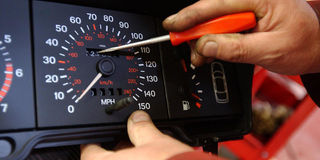Mileage tampering is a terrible reality

Take the car to a mechanic for inspection because they know what parts would be original on an older car.
Buying a used car can be quite difficult and confusing, especially when the matter of mileage comes up. Mileage is often a huge factor in determining the price of a used car, so many people think that low mileage cars are a better deal and will last longer.
As a rule, this is true. A car with fewer kilometres driven will generally last longer before it requires major repairs. This means that you can enjoy a lower cost of ownership, and a more reliable car that will not require constant maintenance.
Exceptions
However, there are exceptions. A two-year-old car with 100,000 kilometres on it will be worth far less than a 10-year-old car with 100,000 kilometres on it. This is especially if the 10-year-old car has been maintained properly. Also, a car that has over 200,000km on the odometer but has been cared for well throughout its entire lifespan will be a much better purchase than a car that has 75,000km logged on the odometer, but has been neglected by a previous owner.
So, while low mileage cars are usually in better shape, it is important to make sure that the car you are buying has been cared for properly. Otherwise, you risk wasting money on a low mileage car that ends up costing you a lot of money in repairs. With the increase in second hand car sales, there has been an increase in certain malpractices too. One such commonly found trick is odometer tampering also known as mileage rollback. Most innocent used car buyers think that with the introduction of advanced computer technology, such things as odometer tampering are a thing of past.
The trick
Unfortunately, there are unethical car dealers and individuals who have got tricks up their sleeves to roll back the odometer and sell their cars for more than they are actually worth. Buyers not only pay too much for their cars, but are often faced with unexpected maintenance and repair expenses for overused cars.
On modern cars you hook up the car to a special tool or laptop via the diagnostic port and apply the correct (sometimes freely available) software and you are done. Zero evidence. On top of this, modern cars, particularly cars that are likely to have high miles such as luxury cars, are much better made, the interior trim does not show signs of use nearly as clearly.
Caution
Naturally, if the car has a lot more miles than the odometer indicates, the probability of major repairs and lots of little things going wrong is greatly increased. However, it is not as simple as it seems. Even experts need to examine the car closely before being able to detect whether the car’s odometer has been tampered with.
For this reason, it is always recommended to consult a reliable mechanic when purchasing a used car. A car with model year 2006, over a decade having mileage of less than 30,000km just does not look right. While this may be true for some special and rare cars that are always garaged, most cars at that age are usually over 100,000 kilometres on average. A quick search online for similar cars will show you the average mileage on the used market.
Use your manual
Most used cars come with service manuals in the glove compartment. Even when in Japanese for Japan imports, the mileage at the service points is usually written so you may check against what’s shown on the odometer.
Low mileage would naturally indicate everything, especially the interior is in good shape. Items such as the brake and accelerator pedals, seats upholstery, steering wheel, gear shift knob and floor mats should not be worn. If they are, then this is an indication of rolled back mileage.
When buying online
Edirisa Matovu, a seasoned car importer, says if you are buying online, try to buy from dealers that have good ratings and reviews. “Also, seek referrals by asking your mechanic, friend, neighbour. The most important thing is that you do your homework,” he adds.
Newer cars
On newer cars, it is almost impossible to roll back the mileage. One has to have some pretty specialised knowledge to do anything. The software that runs the odometer and the car’s other systems is reliant upon complex algorithms that route information to the appropriate location in the car. The display may fail to work or throw an error unless mileage data agrees on all modules.
How to tell
• Ask to see oil change and maintenance receipts and inspection stickers. Examine the mileage on the receipts and inspection stickers and compare to the odometer.
• Look for missing screws on or near the dashboard. If the dashboard is not put together perfectly, the odometer may have been tampered with.
• Inspect the brake pedal and floor mats. If either is worn but the odometer has low mileage, it may be a case of odometer fraud.
• Take the car to a mechanic and ask him to examine it for wear and tear.




